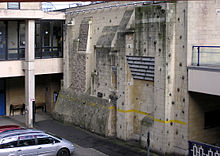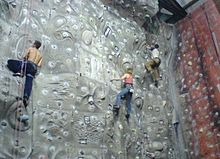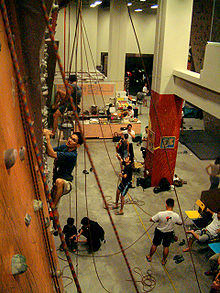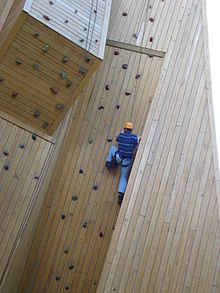- Climbing wall
-
A climbing wall is an artificially constructed wall with grips for hands and feet, usually used for indoor climbing, but sometimes located outdoors as well. Some are brick or wooden constructions, but on most modern walls, the material most often used is a thick multiplex board with holes drilled into it. Recently, manufactured steel and aluminum have also been used. The wall may have places to attach belay ropes, but may also be used to practice lead climbing or bouldering.
Each hole contains a specially formed t-nut to allow modular climbing holds to be screwed on to the wall. With manufactured steel or aluminum walls, an engineered industrial fastener is used to secure climbing holds. The face of the multiplex board climbing surface is covered with textured products including concrete and paint or polyurethane loaded with sand. In addition to the textured surface and hand holds, the wall may contain surface structures such as indentions (incuts) and protrusions (bulges), or take the form of an overhang, underhang or crack.
Some grips are formed to mimic the conditions of outdoor rock, including some that are oversized and can have other grips bolted onto them.
Contents
History
The concept of the artificial climbing wall began in the UK. The first wall was created in 1964 by Don Robinson, a lecturer in Physical Education by inserting pieces of rock into a corridor wall. The first commercial wall was built in Sheffield, traditionally England's centre for climbing due to its proximity to the Peak District.
 An outdoor climbing wall at the University of Bath, England
An outdoor climbing wall at the University of Bath, England
Gym climbing is becoming an increasingly popular urban sport and provides many people with the opportunity to try some aspects of the sport of rock climbing. Bouldering gyms focus on bouldering rather than roped climbing.
Wall types
The simplest type of wall is of plywood construction, known colloquially in the climbing community as a 'woody', with a combination of either bolt-on holds or screw on holds. Bolt-on holds are fixed to a wall with iron bolts which are inserted through the hold, which will have specific bolt points, and then fixed into pre-allocated screw-threaded holes in the wall. Screw-on holds are, by contrast, usually much smaller, owing to the nature of their fixing. These holds are connected to the wall by screws which may be fastened anywhere on the wall's surface.
Other types of walls include slabs of granite, concrete sprayed on to a wire mesh, pre-made fiberglass panels, large trees, manufactured steel and aluminum panels, and textured fiberglass walls.
Routes and grading
 An indoor climbing wall in the UK showing moulded features and coloured route markers.
An indoor climbing wall in the UK showing moulded features and coloured route markers.
 An indoor climbing center in Singapore
An indoor climbing center in Singapore
Holds come in different colours, those of the same colour often being used to denote a route, allowing routes of different difficulty levels to be overlaid on one another. Coloured tape placed under climbing holds is another way that is often used to mark different climbing routes. In attempting a given route, a climber is only allowed to use grips of the designated colour as handholds but is usually allowed to use both handholds and footholds of the designated colour and surface structures and textures of the "rockface" as footholds.
The grade (difficulty) of the route is usually a consensus decision between the setter of the route and the first few people who climb the route.
Many indoor climbing walls have people who are assigned to set these different climbing routes. These people are called route setters or course setters.
As indoor climbing walls are often used to check the development of climber's ability, climbs are color coded.
External links
- UK Climbing Wall Manufacturers Association
- Climbing Wall Association, a US non-profit, industry trade association
Wikimedia Foundation. 2010.



